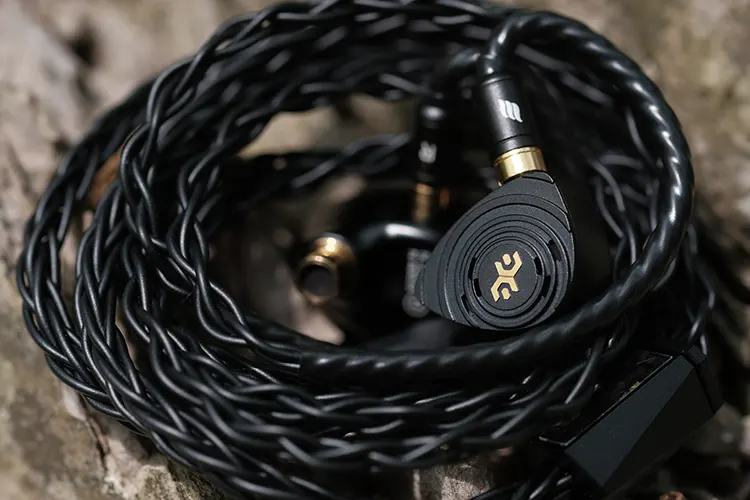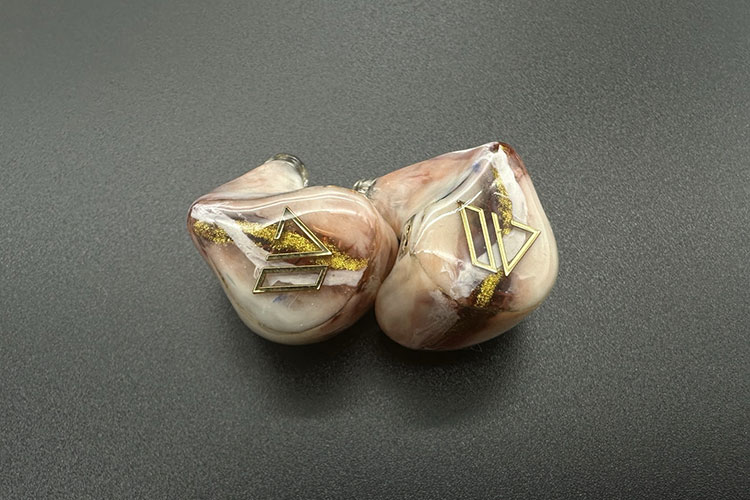Synergy
The Aspire 4 has an impedance of 11Ω @ 1kHz and a sensitivity rating of 104 dB/Vrms. The IEM can be easily driven by lower-powered sources such as dongles and smartphones. The IEM does not ask for a lot of power. I find it pairs well with my MacBook too.
On the Lotoo Paw Gold Touch, the Aspire 4 has a very nice synergy. The IEM benefits from the decent power it offers. There is a decent enhancement to the stage’s spaciousness. The Lotoo DAP adds some warmth to the sound of the Aspire 4. Any extra warmth can be detrimental to the transparency of sound.
With the Earmen Angel, the Aspire 4 has good synergy. The sound is more spacious, and the neutral-bright profile of the Angel helps add some airiness too.
There is no hiss or static background noise on the IEM, which suggests that it can take a good amount of power. The bass quantity is marginally lower on the Angel than on the LPGT.
On the Questyle CMA18P, a DAC/Amp that features an AKM 4493 DAC chipset and patented Current-Mode Amplifier SiP chips CC630/CA630 for high power output, the Aspire 4 performs quite well.
The bass response on the CMA18P is better than that of Angel. The bass and midrange remain neutral, with a touch of warmth. There is some addition of airiness in the treble region, but not as significant as we find on the Angel.
Select Comparisons
64 Audio U4S
Technical
The 64 Audio U4s is a hybrid quad-driver universal IEM with three different types of drivers, a single 9mm dynamic driver for the lows, a balanced armature driver for the low-mids, another for the mid-highs, and 64 Audio’s patented tubeless tia driver for the highs.
The U4S features a 4-way passive crossover that incorporates an electrical low-pass filter to eliminate unwanted frequencies and reduce distortion before they reach the driver.
Additionally, the U4S integrates the Linear Impedance Design (LID) found in the Aspire 4 as well, ensuring consistent and reliable sound quality across various sources.
The U4s has an impedance rating of 11Ω @1kHz and an SPL of 107 dB/mW @ 1kHz @ 1mW (94mV) so it is less demanding compared to the Aspire 4.
Design
The U4S shares a similar build and size with many other 64Audio IEMs, featuring anodized aluminum shells that exude durability and sturdiness.
The shells boast a sleek slate blue matte finish and display the brand’s logo on the faceplate, similar to the Aspire 4. While the Aspire 4 has smaller and lighter shells, the U4S offers superior build quality and enhanced durability.
The nozzles on both of these IEMs are quite long. When it comes to fit, I find that both IEMs offer a comfortable experience. The U4S has smooth and rounded corners that don’t press against the ears, making it suitable for extended wear.
The stock cable on the U4S is a 4-wire 26AWG silver-plated OCC copper cable, which is thicker and better built compared to the IPX cable on the Aspire 4.
This cable comes with a 3.5mm termination. The 2-pin connectors are notably large and angled away from the ears, helping to reduce pressure and enhance wearing comfort.
Additionally, the U4S is bundled with four different APEX modules: M20, M15, M12, and MX modules which offer versatility in sound signature.
Performance
The U4S is a notable step up over the Aspire 4 in various aspects. For comparison, I used the M12 gold module on the U4S.
Both IEMs deliver a similar level of punch and impact in the bass, but the U4S offers superior texture and layering.
While the Aspire 4’s bass is warm and has a bit of midbass bloom, the U4S’s bass is cleaner, with a fast decay and deeper reach. These enhanced bass characteristics make the U4S’s bass more enjoyable overall.
In the midrange, the U4S exhibits a very transparent character, with the bass region not interfering, keeping it clean and clear. In contrast, the midrange of the Aspire 4 lacks this clarity, presenting a warmer tone in comparison.
The lower mids on the Aspire 4 are lusher and richer compared to the U4S. The U4S, however, brings a lot more energy into the midrange, extending up to the higher frequencies.
On the Aspire 4, the upper mids lack this energy, causing vocals and midrange instruments to feel less detailed and not as well-extended.
The introduction of the tia driver in the U4S significantly enhances the treble, making it more detailed and crisper, which is a noticeable improvement over the Aspire 4’s signature. The U4S delivers an airier sound, while the Aspire 4 has a darker and less detailed presentation.
In terms of technical performance, the U4S excels across the board. It offers a wider soundstage and greater depth, creating a more open and spacious listening experience.
Instruments have ample breathing room, which can feel somewhat constrained on the Aspire 4. Additionally, the U4S is more resolving, effectively bringing out micro details that the Aspire 4 sometimes misses. While imaging is a standout aspect of the Aspire 4, the U4S performs similarly in imaging capability.
Effect Audio PILGRIM NOIR
Technical
PILGRIM NOIR is a new hybrid IEM, born from a collaboration between Effect Audio and Elysian Acoustics.
This IEM features four drivers: a 9.2mm LSR dynamic driver for the lows, two Sonion BA drivers for the low-mid and mid-high frequencies, and a Knowles balanced armature for the highs with a 4-way crossover.
The IEM’s specifications include the Hypercore Twin Thrust Module (HTTM). This employs two Sonion BA drivers designed to enhance midrange frequencies by reducing distortion and eliminating unwanted tubing resonance.
Additionally, the custom-built Liquid Silicon Rubber dynamic driver is engineered to deliver a robust low-end. These drivers feature a Magnesium-Aluminium alloy diaphragm, ensuring minimal distortion and detailed low-frequency performance.
The NOIR has a sensitivity of 103 dB @ 1 kHz mW and an impedance of 8.3Ω @ 1 kHz. It does not need a lot of power and can be paired easily with a variety of sources.
Design
The PILGRIM NOIR’s black shells are made of steel with a matte finish and adorned with a striking yellow logo.
Its design showcases Knoll-inspired ridges on the faceplate, with six vents encircling the Elysian logo on one side, and the Effect Audio logo on the other. In terms of aesthetics, the PILGRIM NOIR looks more beautiful.
In terms of size and fit, the PILGRIM NOIR features moderately sized shells that provide a comfortable fit, sitting close to the ears without excessive protrusion.
Its smooth edges ensure there are no pressure points. Comparatively, the Aspire 4 has smaller shells, offering an even more comfortable fit.
The Pentaconn connector used for the IEM shells resembles the MMCX connector but offers a more secure connection. It is easier to remove the cable compared to MMCX, requiring less force to detach.
When compared to the IPX connection system, Pentaconn shares a similar approach to ensuring a reliable and stable connection.
The Eros S: NOIR cable is exclusively built for the PILGRIM NOIR. It is an ultra-pure OCC pure silver and pure copper Litz cable. The ConX and TermX systems enhance its versatility, allowing it to be used with various sources. The cable on Noir is better in both build and aesthetics.
In terms of overall presentation, the PILGRIM NOIR offers significantly more than the Aspire 4. This difference largely stems from the distinct target audiences each IEM is designed for.
Performance
Although the Aspire 4 is designed for professional monitoring, its sound signature closely aligns with what is commonly found in the audiophile community.
This suggests that 64 Audio likely aimed to strike a balance between meeting the needs of both professional users and audiophiles during its development.
The PILGRIM NOIR features a prominent sub-bass, whereas the Aspire 4 focuses more on mid-bass. The Noir delivers a greater overall impact, with superior texture in its bass response.
The midrange on the PILGRIM NOIR is notably lusher and richer. While the vocals on the Aspire 4 are quite decent, the PILGRIM NOIR excels in the vocal department with its fuller presentation.
Vocals on the Noir take center stage, offering a denser and more immersive experience than the slightly thinner vocals on the Aspire 4. Additionally, the PILGRIM NOIR’s midrange exudes more warmth, whereas the Aspire 4 features a cleaner and more transparent midrange.
In the upper frequencies, PILGRIM NOIR features a less energetic lower treble but excels with better treble extension, reaching further into the higher frequency range. The Aspire 4 has a noticeable boost in the lower treble but lacks the airiness and sparkle that PILGRIM NOIR provides.
PILGRIM NOIR has a wider soundstage and a more holographic and spacious presentation. The stage on Aspire 4 is a closer-to-ears presentation.
Detailing is a touch better on PILGRIM NOIR with an expansive stage giving more breathing room to the instruments. The imaging capability is equally good on both IEMs.
Alpha Omega Ra
Technical
The Alpha Omega Ra universal IEM has a tribrid multi-driver configuration. There are a total of 7 drivers with a 4-way passive crossover. This includes a 10mm dynamic driver, 4 Sonion BA drivers, and 2 Sonion EST drivers.
The beryllium-plated 10mm dynamic driver takes care of the lower frequencies, dual BA drivers for the lower mids, and a second dual driver BA set for the upper mids frequencies. The final 2 EST drivers cover the higher treble frequencies.
The Alpha Omega Ra has an impedance rating of 28Ω @1kHz with an SPL of 105 dB/Vrms. Compared to Ra, the Aspire 4 is quite easy to drive.
Design
The Alpha Omega Ra features resin-built shells that are robust and durable, with each one hand-painted to resemble marbles from a distance. The shell design on Ra is inspired by CIEMs and is medium in size, providing a comfortable fit in the ear.
The shells of the Alpha Omega Ra can be customized with different colors and paint designs. In contrast, the Aspire 4 follows a different design language with smaller shells that offer a better fit. The Ra’s wider nozzle can make it challenging to use with narrow bore tips.
Ra connects with a 0.78mm 2-pin connector The IEM comes with a 4-core gold-plated 26AWG Litz copper cable. I find the 2-pin connection very convenient, and the 2-pin cables are quite easily available.
Performance
Ra has a V-shaped signature with an intimate close-to-ears stage, which is similar in presentation to the Aspire 4.
Ra’s bass is sub-bass focused compared to mid-bass focused bass on the Aspire 4. The bass on Ra has a nice impact, something that can satisfy the bassheads too. With better layering and texture in the bass, Ra has an edge.
In the midrange, the Ra delivers pleasant clarity with a subtle warmth. Similar to the Aspire 4, the mids on Ra are presented in a forward manner, providing energy without any sharpness or excessive emphasis in the upper mids.
The presence of EST drivers on Ra gives it an edge in the treble performance. However, in terms of energy and extension, the Aspire 4 is not far behind. Both IEMs have very tamed upper frequencies and miss the airiness and sparkle.
Both the Ra and Aspire 4 offer an intimate soundstage with decent depth, though they both do not extend widely. Both excel in imaging capability, with the Aspire 4 having a slight edge. In terms of micro-details, I find the Ra to perform slightly better.
My Verdict
When I received the 64 Audio Aspire 4, I was uncertain about what to expect from a product specifically designed for professional artists, especially since my experience has primarily been with audiophile-grade IEMs.
However, knowing 64 Audio’s reputation, I had confidence in this IEM. To be honest, I am relieved by the kind of tuning the Aspire 4 has. There are several positive aspects as well as areas for improvement with this release.
The 64 Audio Aspire 4 is the most affordable universal IEM from the company, and its tuning is quite decent, particularly with its bass performance, which adds an enjoyable dimension to the listening experience.
I also appreciate the small size and fit of the IEM. However, there are some drawbacks, such as the IPX connection system, average stage width, and certain technical limitations, which might place it behind some competitors.
The audiophile market has advanced significantly, and there are now some solid offerings at a similar price point. Despite this, I believe the Aspire 4 is quite good when considering its professional monitoring capabilities.
Ultimately, personal preference will play a significant role, but rest assured, the sound quality of the Aspire 4 competes well in its price range.
64 Audio Aspire 4 Specifications
- Frequency Response: 20Hz – 18kHz
- Isolation: -20 dB
- Build: Moulded ABS Shell, Stainless Steel Nozzle
- Impedance: 11Ω @ 1kHz
- IPX Cable: 48″ Black – Detachable, 90 degree 3.5mm Jack
- Driver Configuration: 1 Low Dynamic Driver, 2 Mid Balanced Armature Drivers, and 1 High Balanced Armature Driver
- Sensitivity: 104dB @ 1kHz @1mw





